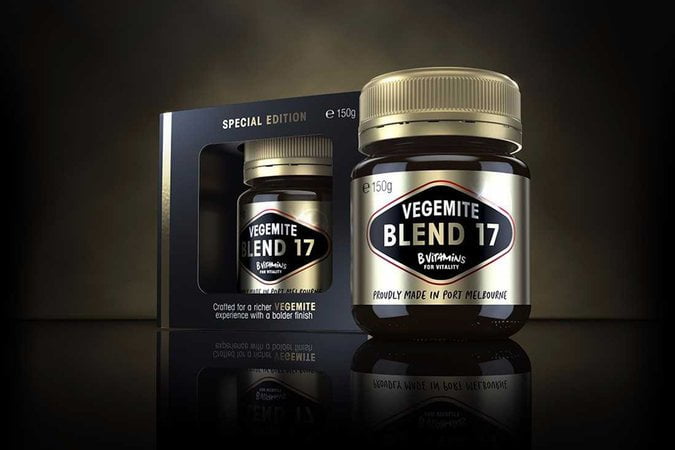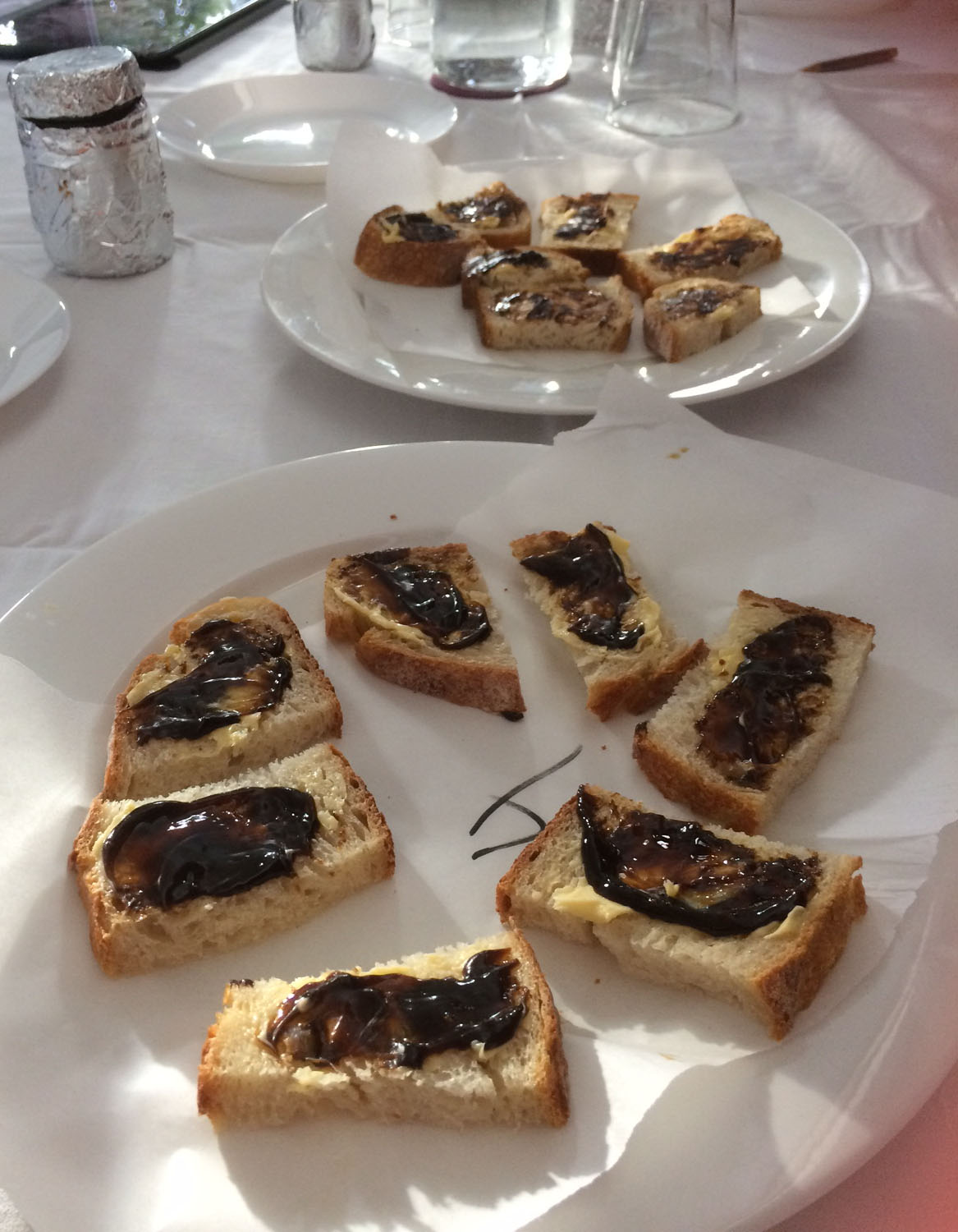Paul van Reyk
In October 2017, Bega Cheese released Blend 17, a limited edition (450,000 units, only to be continued if sales warrant) of the iconic Australian yeast based spread.
The appellation and packaging clearly aim to capitalise on the artisanal zeitgeist of the luxury end of the food market. Blend 17 (echoes of ‘blends’ of whiskey and coffee though the ‘17’ prosaically refers to the year of manufacture and not to anything more arcane) comes in a muddy-gold jar not the familiar sunny yellow, with the red in the familiar logo changed to black, nestled in a slate blue peek-a-boo cardboard box and with a price tag double that of regular Vegemite. The advertorial on the box promotes it as a ‘Special Edition. Crafted for a richer Vegemite experience with a bolder finish. Proudly produced in Port Melbourne’. All that is missing is a terroir note of the microbrewery from which the yeast – native Australian of course – was sourced.

So, does it live up to the hype? A group of Sydney based food writers – both aficionados of Vegemite and non – put it up in a blind tasting against Vegemite classic, Ozemite and Promite.
Ozemite was developed by Australian entrepreneur Dick Smith in a burst of national fervour reportedly on his ‘discovering’ that Vegemite was owned by US based multinational Kraft. In fact Vegemite has been owned by Kraft and subsequently other US multinationals since shortly after its creation in the 1923, most recently Mondelez International. In 2017, Bega bought back ownership of Vegemite. Other than patriotism, Ozemite’s other selling point is that it is not made from brewer’s yeast but from yeast grown on corn, making the spread gluten free. Promite is an Australian competitor of Vegemite first developed in the 1950s and marketed through the Australian Masterfoods brand but was bought out by the US based Mars Incorporated.
For the taste test one tester covered the labelling and lids of each jar with foil. A second tester then then gave each jar a number from 1 – 4. The same tester than generously spread each test sample on several slices of buttered white baguette and placed them on a plate numbered to correspond with the jar from whence it came. This was our version of a ‘double-blind’ test.

We decided on seven test criteria: texture, saltiness, umami, colour, aroma, sweetness, and other which was for anything else the testers wanted to comment on.
Testers could select from the plates as they wished. They could have more than one slice if they needed to confirm impressions – or just liked the flavour of one and were feeling peckish. The foil covered jars were placed on the table during testing so no substitutions could be made. Testers thus could also have a taste of a spread without the bread and butter. No discussion was allowed until all testers confirmed they had tasted/tested sufficient of each sample and had their notes ready. One tester arrived late and reporting on findings and commentary was suspended until she had completed the testing.
Alison: preferred 2#: all of them were too salty; 4# was distinctly different, sweeter, and she and 3#.
John: 1# had a yeasty aroma, sweet on its own (i.e. without the bread and butter); 2# was slightly bitter, more salty and less sweet; 3# was more umami, verging on the bland; 4# best of them, sweetness going pleasantly caramelly.
Paul: preferred 4#, not just salty, more umami, the colour was better, it had a nice glossy finish and it spread best; he was not fond of 2#.
Charmaine: preferred 4#; she couldn’t really tell the others apart; 1# and 3# were bitter; none were overly salty or aromatic.
Nancy: preferred 2#, she liked its saltiness; 3# was bitter and unpleasant; 4# was too sweet, umami, runny; 1# was the sweetest, honeyish.
Jacqui: liked 2# best, pleasantly umami, blue cheese edge, pleasantly piquant; 3# too strong and bitter; 4# very strong, cloyingly sweet, highly unpleasant; 1# had a very nasty chemical taste.
And now the reveal: 1# was Promite; 2# was Vegemite classic; 3# was Vegemite Blend 17; 4# was Ozemite.
So, an even split on preferences between Vegemite classic and Ozemite, with Blend 17 getting the thumbs down from all. What this says about the testers’ taste preferences generally or their patriotism was not subject to discussion.
However, the testing did lead to discussion about spreads in general and particularly at breakfast:
- When did spreads become popular as a breakfast item? Did it occur with the peculiarly English penchant for toasted bread which emerged in the C18th?
- Salty spreads such as anchovy pastes, Gentleman’s Relish etc were popular in toast in C18th
- Marmalade was not a breakfast spread until the early C19th when promoted as a health food by Scottish producers, prior to which it was a dessert or banqueting dish.
- Do we crave/need savoury/salty foods at breakfast?
- Sweet breakfasts still dominant in France, USA – jams, syrups etc.
- Industrial Revolution, formalisation of pre-work day breakfast – convenience foods, quicker than cooked breakfasts.
- Noted that Paul grew up in Sri Lanka where Vegemite was unknown, but he did certainly eat thick slices of untoasted white bread with lashings of jam or honey.
There was also some discussion about the production of vegemite and whether the spent brewer’s yeast constituted ‘waste’ or a ‘by-product’. This arose out of a discussion of the proposal put by Donna Lee Brien in From Waste to Superbrand: The Uneasy Relationship between Vegemite and Its Origins that a suppressed part of the Vegemite story is that it is based on re-cycling food waste, in this case the yeast. The reason for this proposed by Brien is historic consumer aversion to re-cycling food waste. No conclusion was reached on the day on the question of what spent yeast was. However, investigation by the author of this report found that in strict industry terms a by-product is a secondary product derived from a manufacturing process or chemical reaction while waste is any material that is rendered useless during a manufacturing process. Hence, yes, spent yeast is waste. Whether its repurposing in Vegemite and its cohort should be promoted given the current concern for food waste is up for discussion.
We note that Blend 17 is now on sale in supermarkets out of its box and at a price nearer that of classic Vegemite. We await with not-so-bated breath Bega’s announcement of its future.